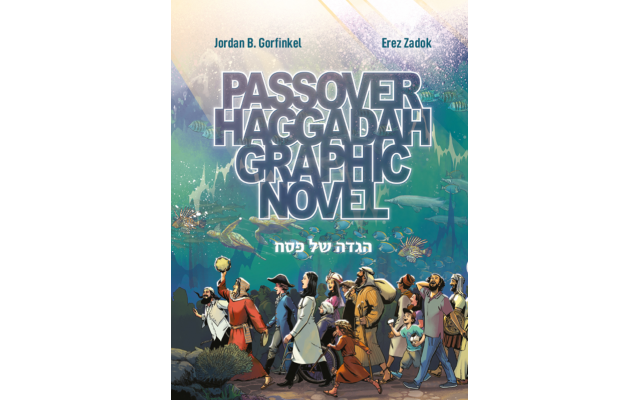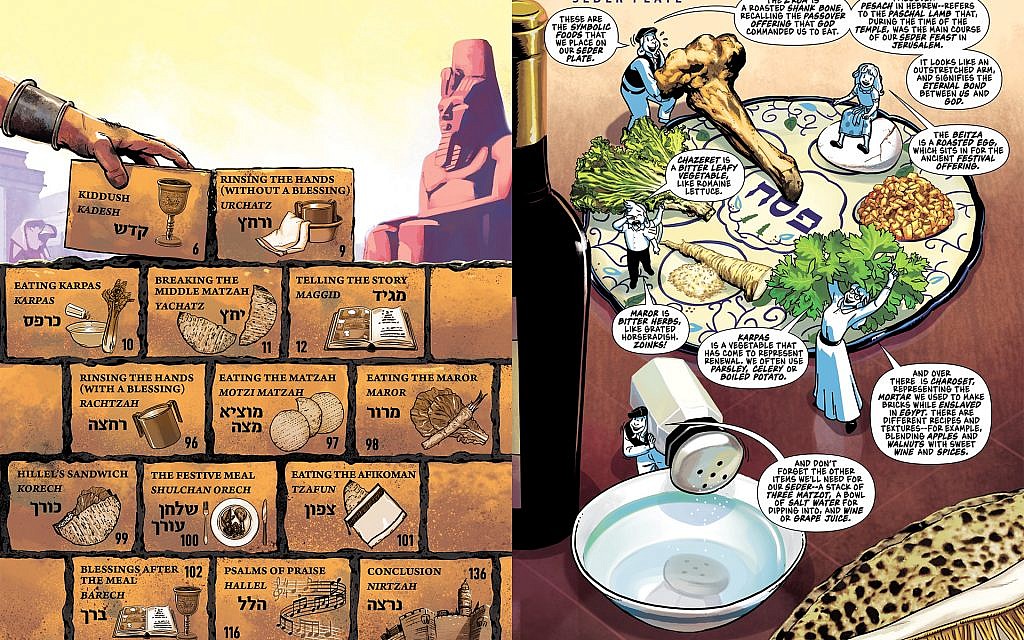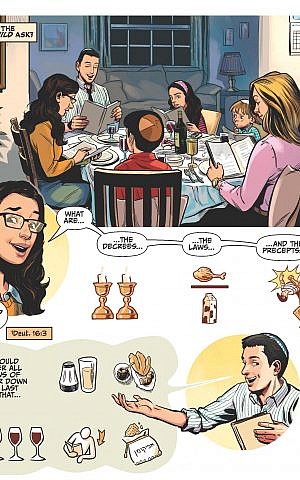Graphic Novel Tells Haggadah Story with Modern Twist
This modern presentation of the ancient Exodus aims to bolster the younger generation’s connection with Judaism.
Rabbi David Geffen is a native Atlantan and Conservative rabbi who lives in Jerusalem.

This modern presentation of the ancient Exodus aims to bolster the younger generation’s connection with Judaism.
“The vast majority of secular Jews in Israel attend a seder every year, as do a huge percentage of diaspora Jews,” writes David Olivestone, the translator of the new 169-page Passover Haggadah Graphic Novel published by Koren Publishers Jerusalem. “So maybe they will see or read something in this new haggadah which will pique their interest.”
Let us travel together through the haggadah and we will encounter exciting illustrated moments that impact us in ways we had not realized in previous years. Early in the text, our guide, one little kid, is dressed in his quasi-Superman outfit with a matzah on his chest. He speaks for [Jordan] Gorfinkel, the creator; [Erez] Zadok, who painted the figures, and Olivestone, the translator.
“We’re connecting a new generation to our living history, by illustrating the fully unabridged authentic text,” he says.
Typically, we are led into the haggadah text by the invitation for anyone to “come and eat.” Gorfinkel introduces us to varied groups of seder attendants in this initial part of the haggadah.

A hiker carrying her pack on her back joins; a young girl spinning a basketball, the whole world, on her finger. Also present is a hip-hop guitarist with a kippah. He puts that musical instrument down and then holds a Torah. He is next to a nattily dressed young man in a blue suit and a red tie. They sit down and start reading the haggadah. In the graphics, recalling the past, we see the four rabbis in Bnei Brak who “elaborate on the story of our rescue from Egypt.”
We recognize the Jewish displaced persons after World War II, then the illegals in a tiny boat on the way to Eretz Yisrael. An American soldier is freeing a little Jewish boy, who is still garbed in a concentration camp suit striped from top to bottom. Now a real surprise: Martin Luther King Jr. and Abraham Joshua Heschel, key American leaders who were champions of freedom and supporters of the State of Israel, appear together.
The two men walked hand in hand on the way to Selma, Ala. in the campaign to free African-Americans. I heard Heschel introduce King at The Rabbinical Assembly convention of Conservative rabbis in 1968. One of King’s key points, stressed that night, was that Israel was an “oasis of peace,” and Heschel always emphasized that Israel was the spiritual capital of the Jewish people. Three weeks later, on April 4, King was assassinated. Heschel marched with other leaders at the funeral procession in Atlanta.

Lastly, among the seder attendees, the Ethiopian Jews finally freed, fly to and deplane in Israel.
In the Four Children illustration, a very smart girl is the “astute” child who knows all; the “rebellious” son, second child, does not want to have anything to do with this seder and runs to his room to bounce a basketball off the wall. His mother soothes him and returns him to the seder table. It is stressed again and again how the Jewish woman – and especially the Jewish mother – is a vibrant participant in the transmission of Judaism.
The “innocent” child, a girl, asks “What is this?” and the father tells her how G-d rescued the Jewish people from the Egyptians. “The child who cannot even put his thoughts in words” must be shown how G-d rescued us. The mother captures the little boy’s interest in a childlike way by having 10 finger puppets representing the 10 plagues.
Two well-known parts of the haggadah text are used to demonstrate what the march of the Jewish people has been through history. For “Dayenu,” starting with a Miriam-like figure holding her timbrel, there are 16 Jews in native costume from their varied homes. We can easily see where all our ancestors have resided throughout history.
The final figure depicted in “Dayenu” is a female doctor. She is feeding her hungry child for she is a professional who makes sure her children experience her presence and benefit from her love of Judaism.
On an enormous iPhone screen, the march through the Red Sea is depicted by Jewish people, ancient and modern. As you gaze at the faces on the screen, you will be surprised by some of the people Gorfinkel selected.
Down the sides of the page are symbols of the different sections of this volume – ancient, but new. When you reach the place in the haggadah of the designated symbol, it pops out on the page.
This Passover, read, peruse, enjoy and catch the interesting symbolism of this unique haggadah. It can only enrich your seder!



comments